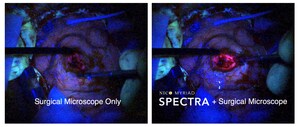Two Major Publications Reveal New Study Data Showing Patients with Deadliest Form of Stroke Now Have Second Chance at Life
INDIANAPOLIS, June 28, 2016 /PRNewswire/ -- New evidence in hemorrhagic stroke care suggests there may now be an answer for safely treating the deadliest, most costly and debilitating form of stroke through early surgical intervention.
Two peer-reviewed studies recently published in Neurosurgery and Operative Neurosurgery, both published by the Congress of Neurological Surgeons – the leader in education and innovation in advancing neurosurgery – show statistically significant data, citing more than 95 percent clot reduction1, the ability to walk in 94 percent of patients (mRS 0-3 at 30-365 days)2, and no mortalities3 in one study with patient groups suffering from hemorrhagic stroke.
Both studies – one prospective single-center study conducted by the Cleveland Clinic and the other a retrospective multi-center study with 11 institutions that included Johns Hopkins, Emory, NorthShore, Indiana University, and Houston Methodist – conclude that the BrainPath Approach™ was safely performed in all patients with a high rate of clot evacuation and a statistically significant improvement in clinical outcomes and functional status and a meaningful reduction in mortality.
"The inertia has been against aggressive surgical intervention for this disease, but there has also been a constant pressure for progress for this group of patients who have had very bleak recovery or survival odds," said Dr. Mark Bain, neurosurgeon at The Cleveland Clinic, in the prospective study published in Operative Neurosurgery. "There has been a need to have data supporting this approach in order to take the big jump for changing how quickly we address hemorrhagic stroke and how we approach it. This is the first step."4
Both studies validate the importance of appropriate patient selection and standardizing the approach to early surgical intervention of hemorrhagic stroke, as well as standardizing the training and technology used, said Jim Pearson, president and CEO of NICO Corporation, maker of the NICO BrainPath® access technology and Myriad® tissue removal technology.
"Hemorrhagic stroke appears to be following in the footsteps of ischemic stroke, with these significant clinical advancements now being published in well-respected neurosurgery journals," Pearson said. "What's emerging is unique and there is no other technology available that allows for access to the brain using a trans-sulcal surgical approach. We can see the market of treatable patients evolving and getting larger for hemorrhagic stroke because now we can intervene quickly and stop the active bleed – something not possible before."
The early results of these studies, with one death out of almost 50 patients combined that was unrelated to the BrainPath Approach5, show great promise in a disease state that averages a more than 50 percent mortality rate. Equally important is the functional recovery of 94 percent of the patients, who had a functional score (mRS) at follow up between 0-3, indicated moderate disability, but able to walk unassisted.6
A real-life example of how this innovative approach and technology can save lives occurred at Seton Brain and Spine in Austin, Texas, when a neurosurgical OR nurse suffered a major hemorrhagic stroke and was brought to the emergency room of the hospital she works at in a coma. Gigi Gelvosa's doctors said she shouldn't have survived, but she was a good candidate for BrainPath and is now on the road to recovery.
In the Cleveland Clinic study with 18 patients published in Operative Neurosurgery, data was clinically significant and identified a treatable patient population that is larger than previously reported, meaning more surgical options that can save patient lives. Key highlights of the study showed successful identification and management of the bleeding vessel in 65 percent of cases, an average of 95.7 percent clot removal, improved median Glasgow Coma Score (GCS) score from 10 to 14, zero re-bleeds throughout the time of follow up, and significantly reduced 30-day mortality rate.
These results are consistent with the multi-center study with 39 patients published in Neurosurgery that showed greater than 90 percent clot reduction in 72 percent of patients. The median GCS improvement from 10 to 14 was statistically significant and no mortalities occurred as a result of the surgery, even with a pre-operative ICH score of 2, which typically indicates a 26 percent mortality rate.
"The consistency of outcomes is a result of our dedication and the neurosurgeons' willingness to attend advanced training courses held across the United States," Pearson said. "During these one-day events, physicians are educated on a unique minimally invasive parafascicular approach that allows for safe access and near complete evacuation, and they are taught techniques for managing the bleeding blood vessel so it doesn't re-bleed after exiting the surgical site. The BrainPath Approach offers a predictable formula for predictable outcomes."
To further validate these early study findings, NICO has partnered with two of Atlanta's nationally renowned comprehensive stroke centers associated with Emory University School of Medicine to perform a randomized controlled trial called ENRICH that will evaluate the clinical effectiveness of early surgical intervention using BrainPath following spontaneous ICH. The Emory Stroke Center of Emory University hospitals and the Marcus Stroke & Neuroscience Center of Grady Memorial Hospital will lead the 15-center trial, ultimately comparing the outcomes between early intervention of clot evacuation in 24 hours or less and medical management of ICH. The trial is slated to begin this year with approximately one year for patient enrollment and 6 months of patient follow up.
In the U.S., more than 795,000 people have a stroke annually – 140,000 will not survive. While hemorrhagic strokes are less common than ischemic strokes, accounting for about 13 percent of all strokes, they tend to be more deadly. The clinical results of the BrainPath Approach have been included in 17 peer-reviewed publications and 14 posters and abstracts. More than 400 neurosurgeons, residents and fellows have been trained on BrainPath and more than 3,000 procedures have been completed.
Learn more about BrainPath and the NICO family of products by visiting www.NICOneuro.com. Procedure videos showing a traumatic, trans-sulcal access with BrainPath can be found on YouTube at NICOneuroCorp.
Contact: Sue Goin
[email protected]
317.402.8690
1Bain,et al. Operative Neurosurgery 2016 "Initial Single-Center Technical Experience w/ the BrainPath System for Acute Intracerebral Hemorrhage"
2Labib MA, Shah M, Kassam AB, et al. The safety and feasibility of image-guided BrainPath-mediated transsulcul hematoma evacuation: a multicenter study. Neurosurgery. 2016: Published online AOP, June 17, 2016
3Labib, et al.
4Bain, et al.
5Bain, et al.
6Labib, et al.
SOURCE NICO Corporation
Related Links
WANT YOUR COMPANY'S NEWS FEATURED ON PRNEWSWIRE.COM?
Newsrooms &
Influencers
Digital Media
Outlets
Journalists
Opted In






Share this article